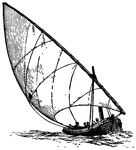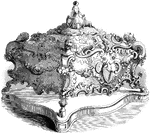Clipart tagged: ‘latin’

Boat with Lateen-sail
A lateen-sail is a triangular sail extended on a yard which is slung one quarter from the lower end…

Back View of the Parts of the Human Body Labeled in English and Latin
Back view of a man. On one lateral the names of the parts are given in English, on the other in Latin.

Front View of the Parts of the Human Body Labeled in English and Latin
Front view of a man in the anatomical position. On one lateral half the parts are labeled in English,…

Wine Cooler
This wine cooler is richly designed on all sides. It has bacchanalian (God of festivities) busts on…

Fates
The three fates of Greek Mythology were three sisters who spun the thread of life named Clotho, Lachesis,…

Faunus
"Sylvanus and Faunus were Latin divinities, whose characteristics are so nearly the same as Pan that…

Pompeii Graffiti from the House of Dioscuri - Gladiator Holding Palm Leaf
A drawing of one section of the graffiti found on the house of Dioscuri in Pompeii. A gladiator descends…

Latin Evangeliarum Rosette Band
The Latin Evangeliarum rosette band is an 8th century design of a flower. It was designed by Godescald…

Sarcophagus of Scipio
"Sarcophagus, plural Sarcophagi, is a kind of stone used among the Greeks for making coffins, and so…
